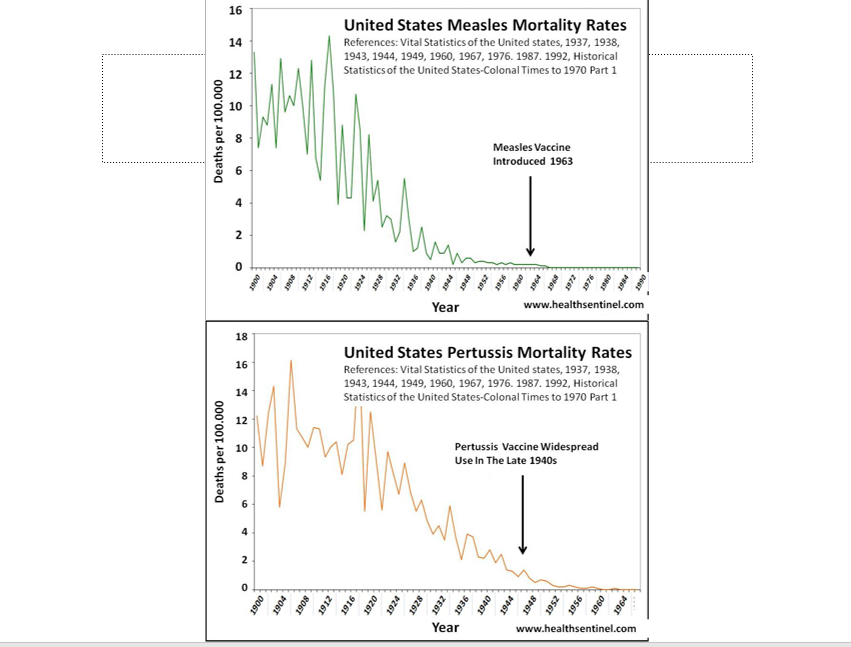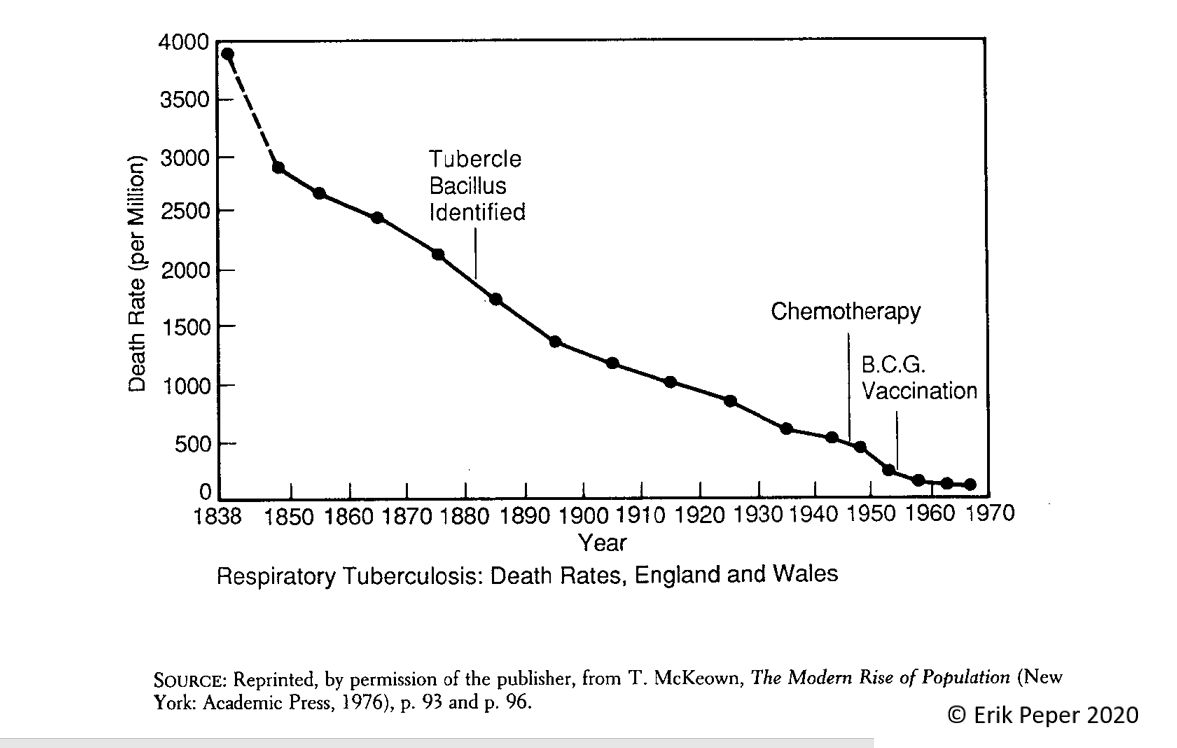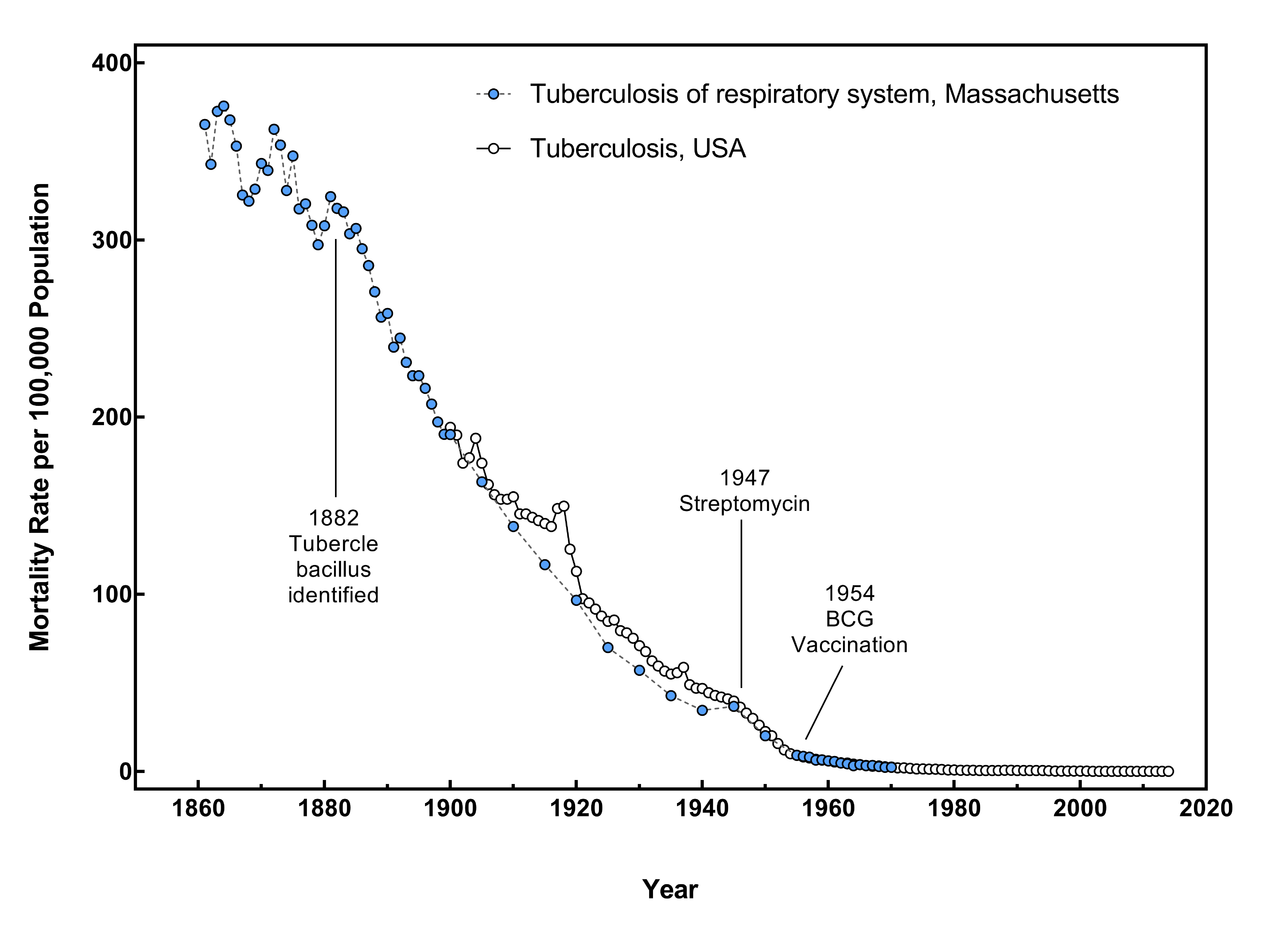The effects of Vaccinations in the General Population on Death Rates
by
Robert Gorter, MD, and Erik Peper, PhD.
May 11th, 2021; updated February 15th, 2022
Currently, we are living during a pandemic with conflicting information and confusing (contradictory) political and public health decisions but which led to believe that strict lockdowns, mandatory testing, and vaccinations would be the only way out: at any cost.
Like in measles, essentially all children got infected and the death toll was close to zero before the vaccinations started.
To make their point, drug companies showed the data over the previous few decades and thus seemingly showing the massive impact vaccinations had. (Figure 1).

Figure 1
However, if one looks at the data over a century, one can see that there was a persistent and consistent decline in the number of deaths and when introduced, immunizations could not have much of an effect on the death rate.
When became vaccinations a tool in public healthcare and well-being?
We have collected a few data from official USA governmental archives and this is what we want to share with you.
We are taught to believe that mass vaccinations brought an end to many diseases; especially childhood diseases and tuberculosis.
We do believe that vaccinations play a role in overcoming and preventing infectious diseases like tetany and Hepatitis B (HBV).
But when we look at childhood diseases like measles, mumps, pertussis, or tuberculosis, we can observe an interesting phenomenon (figure 2):
As an example, death rates per 100,000 dropped for measles and pertussis successively over the previous decades with an exception during World Wars I and II.

Figure 2
These data in figure 1 show that the death rates for measles and pertussis were very much on the decline already since 1900. The same holds true for several more childhood diseases, including chickenpox, mumps, and rubella (not shown here).
Thus, one could document that over the last century the death toll of all childhood diseases (caused by viruses) and several diseases (caused by bacteria-like tuberculosis) were in significant decline long before vaccinations were started anyway.
When we look at death rates for lung tuberculosis, the same trend is there: since the 1850s, persistently, the death rate declined and when antibiotics (in the graph called chemotherapy) were broadly available (ca. 1948) and then the BCG vaccination against tuberculosis was introduced in 1953, there was not much of an effect anyway (figure 3a).

Figure 3a
The pharmaceutical companies claim that the decline of death rates in many infectious diseases went down only because of the development of multiple vaccines do not seem to be confirmed by official public data (Figure 3b)

Figure 3b
(Merged mortality rates of ‘tuberculosis of respiratory system’ in Massachusetts 1861–1970, and ‘tuberculosis’ USA 1900–2014 (Data collected from reports of the US Census Bureau and CDC-Wonder / the US Center for Disease Control (CDC); AMC-University of Amsterdam, 2016)
Bacillus Calmette–Guérin (BCG) vaccine is a vaccine primarily used against tuberculosis (TB). It is partly named after its inventors Albert Calmette and Camille Guérin.
Additionally, it is sometimes used as part of the treatment of bladder and colon cancer; and of malignant melanoma. Through BCG inoculation, the cellular immune system is activated and in oncology, tumors always occur when the cellular immune system is suppressed in its functions (dendritic cells, Natural Killer (NK) cells, etc) (1,2,3,4,5)
If one is not vaccinated for common childhood diseases (measles, chickenpox, mumps, rubella) one will experience the actual illness as a child with the improvement of one’s cellular immune system (Th-1 response).
The actual illness (measles, chickenpox, mumps, rubella) will mature one’s immune system by raising the core body temperature (fever) and skin eruptions. Today, we know that in those skin eruptions (erythemas) dendritic cells undergo a maturing process. Dendritic cells are very important cells that recognize anything “wrong” that comes from outside (i.e. pathogens) and from inside (i.e. cancer cells). There is a lot of data that when one had not had the opportunity to have one’s dendritic cells mature in this way (by childhood diseases and common cold viral infection through adenoviruses, the risk to develop allergies and cancer more often and cancer at an earlier age.
As a child, when parents provided Tylenol® (Paracetamol) to make the child more comfortable after vaccination or during the actual illness, the immune system has less the opportunity to learn to develop a regular immune response.
By going through a childhood disease, one develops life-long immunity which is not always the case after immunization for childhood disease. Getting a childhood disease at an adult age bears much more risk to developing the significant disease with fatal complications. Therefore, when a child has been vaccinated but to assure immunity at adult age, a booster is often recommended by another jab as immunizations do not guarantee life-long immunity.
Were vaccinations the main cause of the decline of death rates?
The only way to answer that question is to do a controlled study. Or, follow death rates over long periods of time and have that period before starting the vaccination as a “historic control.”
We did the second option as there will never be an opportunity to conduct a controlled study.
Conclusion:
The introduction of vaccinations against childhood diseases and other infectious illnesses does not seem the have had a significant effect on mortality, as the Pharmaceutical Industry likes to claim.
References:
1 Fuge O, Vasdev N, Allchorne P, Green JS (May 2015). “Immunotherapy for bladder cancer”. Research and Reports in Urology. 7: 65–79. doi:10.2147/RRU.S63447. PMC 4427258. PMID 26000263.
2 Houghton BB, Chalasani V, Hayne D, Grimison P, Brown CS, Patel MI, et al. (May 2013). “Intravesical chemotherapy plus bacille Calmette-Guérin in non-muscle-invasive bladder cancer: a systematic review with meta-analysis”. BJU International. 111 (6): 977–83. doi:10.1111/j.1464-410X.2012.11390.x. PMID 23253618. S2CID 24961108.
3 Uyl-de Groot CA, Vermorken JB, Hanna MG Jr, Verboom P, Groot MT, Bonsel GJ, Meijer CJ, Pinedo HM. Immunotherapy with autologous tumor cell-BCG vaccine in patients with colon cancer: a prospective study of medical and economic benefits. Vaccine. 2005 Mar 18;23(17-18):2379-87. DOI: 10.1016/j.vaccine.2005.01.015. PMID: 15755632.
4 Harris JE, Ryan L, Hoover HC Jr, Stuart RK, Oken MM, Benson AB 3rd, Mansour E, Haller DG, Manola J, Hanna MG Jr. Adjuvant active specific immunotherapy for stage II and III colon cancer with an autologous tumor cell vaccine: Eastern Cooperative Oncology Group Study E5283. J Clin Oncol. 2000 Jan;18(1):148-57. DOI: 10.1200/JCO.2000.18.1.148. PMID: 10623705.
5 Stewart JH 4th, Levine EA. Role of bacillus Calmette-Guérin in the treatment of advanced melanoma. Expert Rev Anticancer Ther. 2011 Nov;11(11):1671-6. DOI: 10.1586/era.11.163. PMID: 22050015.
http://robert-gorter.info/atopy-children-families-anthroposophic-lifestyle/